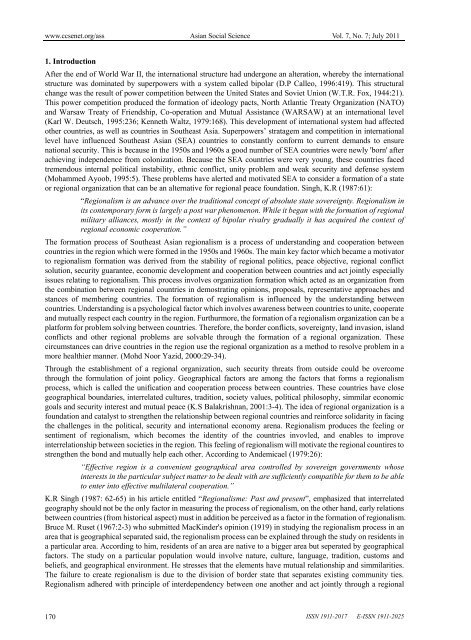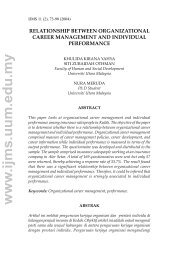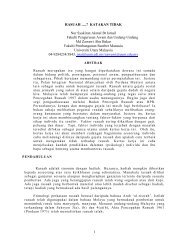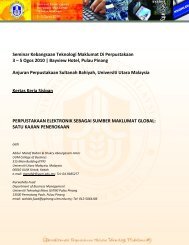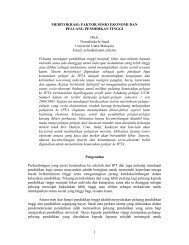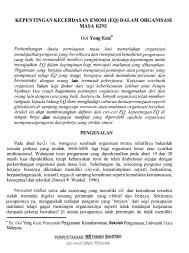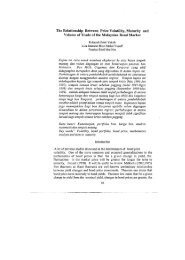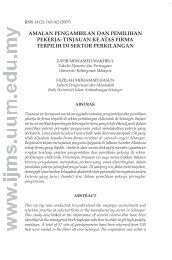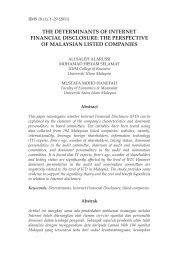The Development of ASEAN from Historical Approach
The Development of ASEAN from Historical Approach
The Development of ASEAN from Historical Approach
Create successful ePaper yourself
Turn your PDF publications into a flip-book with our unique Google optimized e-Paper software.
www.ccsenet.org/ass Asian Social Science Vol. 7, No. 7; July 2011<br />
1. Introduction<br />
After the end <strong>of</strong> World War II, the international structure had undergone an alteration, whereby the international<br />
structure was dominated by superpowers with a system called bipolar (D.P Calleo, 1996:419). This structural<br />
change was the result <strong>of</strong> power competition between the United States and Soviet Union (W.T.R. Fox, 1944:21).<br />
This power competition produced the formation <strong>of</strong> ideology pacts, North Atlantic Treaty Organization (NATO)<br />
and Warsaw Treaty <strong>of</strong> Friendship, Co-operation and Mutual Assistance (WARSAW) at an international level<br />
(Karl W. Deutsch, 1995:236; Kenneth Waltz, 1979:168). This development <strong>of</strong> international system had affected<br />
other countries, as well as countries in Southeast Asia. Superpowers’ stratagem and competition in international<br />
level have influenced Southeast Asian (SEA) countries to constantly conform to current demands to ensure<br />
national security. This is because in the 1950s and 1960s a good number <strong>of</strong> SEA countries were newly 'born' after<br />
achieving independence <strong>from</strong> colonization. Because the SEA countries were very young, these countries faced<br />
tremendous internal political instability, ethnic conflict, unity problem and weak security and defense system<br />
(Mohammed Ayoob, 1995:5). <strong>The</strong>se problems have alerted and motivated SEA to consider a formation <strong>of</strong> a state<br />
or regional organization that can be an alternative for regional peace foundation. Singh, K.R (1987:61):<br />
“Regionalism is an advance over the traditional concept <strong>of</strong> absolute state sovereignty. Regionalism in<br />
its contemporary form is largely a post war phenomenon. While it began with the formation <strong>of</strong> regional<br />
military alliances, mostly in the context <strong>of</strong> bipolar rivalry gradually it has acquired the context <strong>of</strong><br />
regional economic cooperation.”<br />
<strong>The</strong> formation process <strong>of</strong> Southeast Asian regionalism is a process <strong>of</strong> understanding and cooperation between<br />
countries in the region which were formed in the 1950s and 1960s. <strong>The</strong> main key factor which became a motivator<br />
to regionalism formation was derived <strong>from</strong> the stability <strong>of</strong> regional politics, peace objective, regional conflict<br />
solution, security guarantee, economic development and cooperation between countries and act jointly especially<br />
issues relating to regionalism. This process involves organization formation which acted as an organization <strong>from</strong><br />
the combination between regional countries in demostrating opinions, proposals, representative approaches and<br />
stances <strong>of</strong> membering countries. <strong>The</strong> formation <strong>of</strong> regionalism is influenced by the understanding between<br />
countries. Understanding is a psychological factor which involves awareness between countries to unite, cooperate<br />
and mutually respect each country in the region. Furthurmore, the formation <strong>of</strong> a regionalism organization can be a<br />
platform for problem solving between countries. <strong>The</strong>refore, the border conflicts, sovereignty, land invasion, island<br />
conflicts and other regional problems are solvable through the formation <strong>of</strong> a regional organization. <strong>The</strong>se<br />
circumstances can drive countries in the region use the regional organization as a method to resolve problem in a<br />
more healthier manner. (Mohd Noor Yazid, 2000:29-34).<br />
Through the establishment <strong>of</strong> a regional organization, such security threats <strong>from</strong> outside could be overcome<br />
through the formulation <strong>of</strong> joint policy. Geographical factors are among the factors that forms a regionalism<br />
process, which is called the unification and cooperation process between countries. <strong>The</strong>se countries have close<br />
geographical boundaries, interrelated cultures, tradition, society values, political philosophy, simmilar economic<br />
goals and security interest and mutual peace (K.S Balakrishnan, 2001:3-4). <strong>The</strong> idea <strong>of</strong> regional organization is a<br />
foundation and catalyst to strengthen the relationship between regional countries and reinforce solidarity in facing<br />
the challenges in the political, security and international economy arena. Regionalism produces the feeling or<br />
sentiment <strong>of</strong> regionalism, which becomes the identity <strong>of</strong> the countries invovled, and enables to improve<br />
interrelationship between societies in the region. This feeling <strong>of</strong> regionalism will motivate the regional countires to<br />
strengthen the bond and mutually help each other. According to Andemicael (1979:26):<br />
“Effective region is a convenient geographical area controlled by sovereign governments whose<br />
interests in the particular subject matter to be dealt with are sufficiently compatible for them to be able<br />
to enter into effective multilateral cooperation.”<br />
K.R Singh (1987: 62-65) in his article entitled “Regionalisme: Past and present”, emphasized that interrelated<br />
geography should not be the only factor in measuring the process <strong>of</strong> regionalism, on the other hand, early relations<br />
between countries (<strong>from</strong> historical aspect) must in addition be perceived as a factor in the formation <strong>of</strong> regionalism.<br />
Bruce M. Ruset (1967:2-3) who submitted MacKinder's opinion (1919) in studying the regionalism process in an<br />
area that is geographical separated said, the regionalism process can be explained through the study on residents in<br />
a particular area. According to him, residents <strong>of</strong> an area are native to a bigger area but seperated by geographical<br />
factors. <strong>The</strong> study on a particular population would involve nature, culture, language, tradition, customs and<br />
beliefs, and geographical environment. He stresses that the elements have mutual relationship and simmilarities.<br />
<strong>The</strong> failure to create regionalism is due to the division <strong>of</strong> border state that separates existing community ties.<br />
Regionalism adhered with principle <strong>of</strong> interdependency between one another and act jointly through a regional<br />
170<br />
ISSN 1911-2017 E-ISSN 1911-2025


